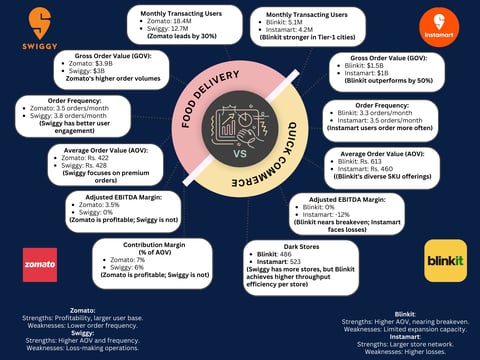Swiggy V/s Zomato
The food delivery sector in India is thriving, with Swiggy and Zomato leading the charge. While both platforms are household names, they differ significantly in their strategies, services, and performance metrics. This article breaks down the battle between Swiggy and Zomato, examining their strengths, weaknesses, and market presence.
Shubhi Jain
12/4/20243 min read
1. Market Presence and User Base
When it comes to monthly transacting users, Zomato takes the lead with 18.4 million users compared to Swiggy’s 12.7 million. This gives Zomato a 30% advantage, reflecting its wider reach and popularity across various regions. However, Swiggy compensates with higher engagement through its premium offerings and diverse services.
2. Gross Order Value (GOV): Who Generates More Revenue?
The Gross Order Value (GOV) provides insights into the overall transaction volume handled by these platforms. Zomato reported a GOV of $3.9 billion, overshadowing Swiggy's $3 billion. This edge is largely attributed to Zomato’s higher order volumes and larger customer base, positioning it as the stronger revenue generator.
3. Average Order Value (AOV)
Despite trailing in user base and GOV, Swiggy excels in Average Order Value (AOV). The platform boasts an AOV of ₹428 compared to Zomato’s ₹422. Swiggy’s focus on premium and high-value orders gives it a competitive edge in maximizing revenue per transaction.
4. Order Frequency
Swiggy’s users demonstrate higher order frequency, averaging 3.8 orders per month compared to Zomato’s 3.5. This metric highlights Swiggy’s ability to foster loyalty and repeat business, likely driven by its seamless user experience and superior app interface.
5. Profitability and Financial Performance
One of the most critical aspects of this rivalry is profitability. Zomato has achieved profitability, with an adjusted EBITDA margin of 3.5%. In contrast, Swiggy operates at a loss, with no positive EBITDA margin. This disparity underscores Zomato’s effective cost management and scalability.
6. Contribution Margins
Contribution margins represent the percentage of revenue retained after deducting variable costs. Zomato’s contribution margin stands at 7%, compared to Swiggy’s 6%. While both platforms are close, Zomato’s margin signals better financial health and operational efficiency.
7. Quick Commerce: Blinkit vs Instamart
Both Swiggy and Zomato have ventured into quick commerce with Instamart and Blinkit, respectively. Here's how they stack up:
Gross Order Value: Blinkit outshines Instamart with a GOV of $1.5 billion versus $1 billion.
Average Order Value: Blinkit leads with ₹613 per order compared to Instamart’s ₹460.
Order Frequency: Instamart has a slight advantage with 3.5 orders per month versus Blinkit’s 3.3.
This segment reveals an intriguing rivalry within the broader battle of Swiggy vs Zomato.
8. Dark Store Operations
Quick commerce relies heavily on efficient logistics and dark store networks. Swiggy’s Instamart operates with 523 dark stores, surpassing Blinkit’s 486. However, Blinkit compensates with higher throughput efficiency per store, allowing it to manage operations more effectively despite a smaller network.
9. User Experience and App Features
Swiggy is often lauded for its user-friendly app interface and engaging features. Its app design prioritizes intuitive navigation, quick reordering, and personalized recommendations. Meanwhile, Zomato excels in content-driven marketing, with user reviews, ratings, and detailed menus playing a significant role in attracting and retaining users.
10. Strengths and Weaknesses
Zomato’s Strengths:
Profitability: Strong financial performance with positive EBITDA margins.
Larger User Base: Wider reach and higher monthly transacting users.
Zomato’s Weaknesses:
Lower Order Frequency: Slightly less engaging for repeat users compared to Swiggy.
Swiggy’s Strengths:
Higher AOV: Focuses on premium orders, ensuring more revenue per transaction.
Superior User Engagement: Leads in order frequency and app experience.
Swiggy’s Weaknesses:
Loss-Making Operations: Yet to achieve profitability.
Conclusion: The Verdict
The battle of Swiggy vs Zomato is far from over, as both platforms continue to innovate and adapt to consumer demands. Zomato leads in user base, revenue, and profitability, making it a dominant force in the food delivery space. However, Swiggy’s higher AOV, order frequency, and user engagement reflect its potential to disrupt the market further.
Ultimately, the choice between Swiggy and Zomato boils down to individual preferences. While Zomato offers a broader reach and financial stability, Swiggy excels in premium services and user loyalty. Both platforms are reshaping India’s food delivery landscape, ensuring a win for consumers no matter which app they choose.

